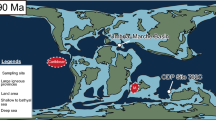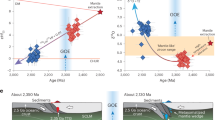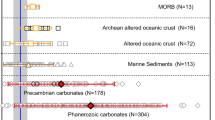Abstract
It is widely accepted that Earth’s early atmosphere contained less than 0.001 per cent of the present-day atmospheric oxygen (O2) level, until the Great Oxidation Event resulted in a major rise in O2 concentration about 2.4 billion years ago1. There are multiple lines of evidence for low O2 concentrations on early Earth, but all previous observations relate to the composition of the lower atmosphere2 in the Archaean era; to date no method has been developed to sample the Archaean upper atmosphere. We have extracted fossil micrometeorites from limestone sedimentary rock that had accumulated slowly 2.7 billion years ago before being preserved in Australia’s Pilbara region. We propose that these micrometeorites formed when sand-sized particles entered Earth’s atmosphere and melted at altitudes of about 75 to 90 kilometres (given an atmospheric density similar to that of today3). Here we show that the FeNi metal in the resulting cosmic spherules was oxidized while molten, and quench-crystallized to form spheres of interlocking dendritic crystals primarily of magnetite (Fe3O4), with wüstite (FeO)+metal preserved in a few particles. Our model of atmospheric micrometeorite oxidation suggests that Archaean upper-atmosphere oxygen concentrations may have been close to those of the present-day Earth, and that the ratio of oxygen to carbon monoxide was sufficiently high to prevent noticeable inhibition of oxidation by carbon monoxide. The anomalous sulfur isotope (Δ33S) signature of pyrite (FeS2) in seafloor sediments from this period, which requires an anoxic surface environment4, implies that there may have been minimal mixing between the upper and lower atmosphere during the Archaean.
This is a preview of subscription content, access via your institution
Access options
Subscribe to this journal
Receive 51 print issues and online access
$199.00 per year
only $3.90 per issue
Buy this article
- Purchase on Springer Link
- Instant access to full article PDF
Prices may be subject to local taxes which are calculated during checkout




Similar content being viewed by others
References
Lyons, T. W., Reinhard, C. T. & Planavsky, N. J. The rise of oxygen in Earth’s early ocean and atmosphere. Nature 506, 307–315 (2014)
Farquhar, J., Zerkle, A. L. & Bekker, A. in Treatise in Geochemistry Vol. 6, The Atmosphere – History (eds Holland, H. & Turekian, K. ) 91–138 (2014)
Som, S. M., Catling, D. C., Harnmeijer, J. P., Polivka, P. M. & Buick, R. Air density 2.7 billion years ago limited to less than twice modern levels by fossil raindrop imprints. Nature 484, 359–362 (2012)
Pavlov, A. A. & Kasting, J. F. Mass-independent fractionation of sulfur isotopes in Archean sediments: strong evidence for an anoxic Archean atmosphere. Astrobiology 2, 27–41 (2002)
Rasmussen, B. & Buick, R. Redox state of the Archean atmosphere: evidence from detrital heavy minerals in ca. 3250–2750 Ma sandstones from the Pilbara Craton, Australia. Geology 27, 115–118 (1999)
Rye, R. & Holland, H. D. Paleosols and the evolution of atmospheric oxygen: a critical review. Am. J. Sci. 298, 621–672 (1998)
Bekker, A. et al. Iron formation: the sedimentary product of a complex interplay among mantle, tectonic, and biospheric processes. Econ. Geol. 105, 467–508 (2010)
Buick, R. The antiquity of oxygenic photosynthesis: evidence from stromatolites in sulphate-deficient Archaean lakes. Science 255, 74–77 (1992)
Eigenbrode, J. L. & Freeman, K. H. Late Archean rise of aerobic microbial ecosystems. Proc. Natl Acad. Sci. USA 103, 15759–15764 (2006)
Konhauser, K. O. et al. Oceanic nickel depletion and a methanogen famine before the Great Oxidation Event. Nature 458, 750–753 (2009)
Farquhar, J. & Wing, B. A. Multiple sulfur isotopes and the evolution of the atmosphere. Earth Planet. Sci. Lett. 213, 1–13 (2003)
Cioni, R., Marianelli, P., Santacroce, R. & Sbrana, A. in Encyclopedia of Volcanoes (ed. Sigurdsson, H. ) 477–494 (Academic, 2000)
Finlayson-Pitts, B. & Pitts, J. Chemistry of the Upper and Lower Atmosphere: Theory, Experiments, and Applications (Elsevier, 1999)
Love, S. G. & Brownlee, D. E. Heating and thermal transformation of micrometeoroids entering the Earth's atmosphere. Icarus 89, 26–43 (1991)
Rietmeijer, F. J. M. & Nuth, J. A. Collected extraterrestrial materials: constraints on meteor and fireball compositions. Earth Moon Planets 82–83, 325–350 (2000)
Genge, M., Engrand, C., Gounelle, M. & Taylor, S. The classification of micrometeorites. Meteorit. Planet. Sci. 43, 497–515 (2008)
Tianrui, S., Zhengjun, H., Yusheng, W. & Yanxue, L. A study of Mesoproterozoic iron cosmic micro-spherules from 1.8 Ga and 1.6 Ga old strata in the Ming Tombs District, Beijing. Acta Geol. Sin. 81, 649–657 (2007)
Awramik, S. M. & Bucheim, H. P. A giant, Late Archean lake system: the Meentheena Member (Tumbiana Formation; Fortescue Group), Western Australia. Precambr. Res. 174, 215–240 (2009)
Blake, T. S., Buick, R., Brown, S. J. A. & Barley, M. E. Geochronology of a Late Archaean flood basalt province in the Pilbara Craton, Australia: constraints on basin evolution, volcanic and sedimentary accumulation, and continental drift rates. Precambr. Res. 133, 143–173 (2004)
Trendall, A. F., Compston, W., Nelson, D. R., De Laeter, J. R. & Bennett, V. C. SHRIMP zircon ages constraining the depositional chronology of the Hamersley Group, Western Australia. Aust. J. Earth Sci. 51, 621–644 (2004)
Rudraswami, N. G. et al. Refractory metal nuggets in different types of cosmic spherules. Geochim. Cosmochim. Acta 131, 247–266 (2014)
Chevrier, V., Rochette, P., Mathe, P.-E. & Grauby, O. Weathering of iron-rich phases in simulated Martian atmospheres. Geology 32, 1033–1036 (2004)
Kasting, J. F. in Treatise in Geochemistry Vol. 6, The Atmosphere – History (eds Holland, H. & Turekian, K. ) 157–175 (2014)
Abuluwefa, H. T., Guthrie, R. I. L. & Ajersch, F. Oxidation of low carbon steel in multicomponent gases: Part I. Reaction mechanisms during isothermal oxidation. Metall. Mater. Trans A 28, 1633–1641 (1997)
Bredesen, R. & Kofstad, P. On the oxidation of iron in CO2 + CO mixtures. III: Coupled linear parabolic kinetics. Oxidat. Metals 36, 27–56 (1991)
Genge, M. The origins of I-type spherules and the atmospheric entry of iron micrometeoroids. Meteorit. Planet. Sci. (in the press)
Legras, B., Joseph, B. & Lefevre, F. Vertical diffusivity in the lower stratosphere from Lagrangian back-trajectory reconstructions of ozone profiles. J. Geophys. Res. 108, 4562, http://dx.doi.org/10.1029/2002JD003045 (2003)
Fulchignoni, M. et al. In situ measurements of the physical characteristics of Titan’s environment. Nature 438, 785–791 (2005)
Zahnle, K., Claire, M. & Catling, D. The loss of mass-independent fractionation in sulfur due to a Palaeoproterozoic collapse of atmospheric methane. Geobiology 4, 271–283 (2006)
Krull-Davatzes, A. E., Byerley, G. R. & Lowe, D. R. Evidence for a low-O2 Archean atmosphere from nickel-rich chrome spinels in 3.24 Ga impact spherules, Barberton greenstone belt, South Africa. Earth Planet. Sci. Lett. 296, 319–328 (2010)
Goldin, T. J. & Melosh, H. J. Self-shielding of thermal radiation by Chicxulub impact ejecta: firestorm or fizzle? Geology 37, 1135–1138 (2009)
de Faria, D. L. A., Silva, S. V. & De Oliveira, M. T. Raman microspectroscopy of some iron oxides and oxyhydroxides. J. Raman Spectrosc. 28, 873–878 (1997)
Wang, J., Davis, A. M., Clayton, R. N. & Mayeda, T. K. Kinetic isotopic fractionation during the evaporation of the iron oxide from liquid state. Proc. Lunar Planet. Sci. Conf. 25, 1459–1460 (1994)
Acknowledgements
We thank N. Wilson and A. Langendam for assistance with electron microprobe work and electron microscopy, respectively. The authors acknowledge use of the Monash Centre for Electron Microscopy, and use of the CSIRO Microbeam Laboratory. Part of this research was undertaken on the powder diffraction beamline at the Australian Synchrotron, Victoria, Australia. M.G. acknowledges STFC grant number ST/J001260/1.
Author information
Authors and Affiliations
Contributions
A.G.T. conceptualized the project, conducted fieldwork and EMP analysis, and wrote the paper. L.B. conducted fieldwork, micrometeorite separation and SEM analysis. M.G. generated the micrometeorite oxidation model. S.W. advised on micrometeorite separation, conducted Raman spectroscopy and interpreted synchrotron results. H.E.A.B. conducted the synchrotron analysis. J.L.W. modelled the oxidizing conditions imposed at equilibrium by different atmospheres. All authors reviewed the paper prior to submission.
Corresponding author
Ethics declarations
Competing interests
The authors declare no competing financial interests.
Extended data figures and tables
Extended Data Figure 1 Geological map showing the context of the sampling location (red star), and examples of the samples used in the study.
The samples in photos a and b show examples of the fine laminations that occur in some layers of this unit. In a, buff coloured zones along cracks highlight examples of modern day oxidative weathering, whereas the grey colouration of the remainder of the sample indicates that it was not weathered, allowing survival of the micrometeorites. Weathered rock was removed using a diamond saw before micrometeorite separation. The geological map (top) is provided courtesy of the Geological Survey of Western Australia, Department of Mines and Petroleum. Copyright State of Western Australia, 2016.
Extended Data Figure 2 Examples of modern iron-type micrometeorites collected from the Antarctic ice sheet.
a, b, Secondary electron images showing the typical exterior morphology. c, d, Back-scattered electron (BSE) images of polished cross-sections of two other micrometeorites, highlighting the interior mineralogical variation. e, BSE image showing an example of a partially weathered modern micrometeorite in cross-section where the metal (outlined by the dashed yellow line) has been replaced by iron oxides and iron oxyhydroxides after arriving on the surface; expansion has led to cracking in the surrounding wüstite and magnetite, which would destroy the micrometeorite if continued. Note that the wüstite and magnetite are unaffected by the weathering. All imaging by M.G.
Extended Data Figure 3 Results of laser Raman spectroscopy confirming the identity of wüstite.
Wüstite is metastable below 570 °C and decomposes to haematite when higher laser power is used, whereas magnetite does not decompose in this fashion32. The iron oxide in the sectioned micrometeorite shown in Fig. 1f gave the spectrum shown in a at 1.5 mW and decomposed to produce the spectrum shown in a at 7.5 mW laser power, consistent with the characteristics of wüstite. Panel b shows the characteristic spectra of magnetite and wüstite from ref. 32; note the arrowed bumps that characterize magnetite, which are missing in wüstite, and the broadened main peak of wüstite. Panel b is modified from ref. 32 with permission from John Wiley and Sons, license number 3850481150510.
Extended Data Figure 4 Two synchrotron powder X-ray diffraction patterns, each collected from a single micrometeorite, and reference positions of magnetite peaks.
Not all major Bragg peaks for magnetite are detected, and deviation from the expected relative intensities of peaks is observed, as a consequence of poor particle size statistics (PDF 01-071-8338 refers to a Powder Diffraction File from the International Centre for Diffraction Data database; http://www.icdd.com/).
Extended Data Figure 5 Equilibrium modelling of the oxidizing conditions imposed by different atmospheres relative to the stability fields of haematite, magnetite and wüstite.
These models (oxygen fugacity versus temperature) represent the stability fields at equilibrium and do not consider the time needed to attain equilibrium (refer to Extended Data Fig. 6). In a, the top of each coloured band represents the conditions imposed by the maximum dynamic ram pressure (0.02 bar) experienced by micrometeorites, which applies to the largest and fastest micrometeorites; the bottom of each band is more relevant to the small micrometeorites observed in this study (0.001 bar). In b, the model for an atmosphere containing 90% N2 and 10% CO2 is shown, with contours for pressure to allow a comparison with atmospheres of different CO2 abundance.
Extended Data Figure 6 Results of experiments on oxidation of low carbon steel in different gas mixes.
These are the results of experiments conducted at 1,100 °C and atmospheric pressure (1 bar); the gas mix is shown on the curves, the remaining gas being N2. Oxidation was measured by progressive weight gain over time. The conditions of survivable micrometeorite entry are 400–2,800 °C and dynamic ram pressure of the order of 0.001–0.02 bar for <2 s. Higher temperatures result in more effective oxidation, lower pressures result in less effective oxidation. This figure was compiled by amalgamating figures 1 and 8 from ref. 24, with permission from Springer, license number 3850591244373.
Extended Data Figure 7 Results of atmospheric entry modelling.
a–c, Plots of entry angle in degrees versus initial radius of micrometeorite in μm. a, Peak temperatures reached by I-type spherules (numbers on curves in °C) entering the atmosphere at 12 km s−1. Note that heating is greater for larger particles undergoing vertical atmospheric entry. The high density of metal micrometeoroids leads to higher peak temperatures than silicate-dominated particles. b, Altitude at which peak temperature is reached for I-type spherules (numbers on curves, in km) with an entry velocity of 12 km s−1. Particles with higher entry velocity have similar peak altitudes since mass loss through evaporation leads to increased deceleration. c, The final radii of I-type particles (numbers on curves, in μm) after deceleration at entry velocities of 12 km s−1 (black) and 18 km s−1 (grey). Greater mass loss occurs at higher entry velocities, entry angles and particle sizes. Mass loss occurs by surface evaporation of the exterior oxide melt.
Rights and permissions
About this article
Cite this article
Tomkins, A., Bowlt, L., Genge, M. et al. Ancient micrometeorites suggestive of an oxygen-rich Archaean upper atmosphere. Nature 533, 235–238 (2016). https://doi.org/10.1038/nature17678
Received:
Accepted:
Published:
Issue Date:
DOI: https://doi.org/10.1038/nature17678
Comments
By submitting a comment you agree to abide by our Terms and Community Guidelines. If you find something abusive or that does not comply with our terms or guidelines please flag it as inappropriate.



